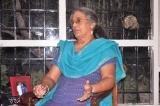
The Indian diaspora understood the meaning of democracy in USA: Savitri Sawhney
Gadar or Ghadar Movement, as some call it, is one of the early freedom struggle movements that was originated in the Diaspora. Pandurang Khankhoje was one of the founding fathers of the Movement on whose life, the book “I shall Never Ask for Pardon: A Memoir of Pandurang Khankhoje” was written by his daughter Savitri Sawhney published by Penguin India in 2008. In an interview with Sadananda Sahoo, Ajay Mahurkar and Rakesh Ranjan, Savitri Sawhney recounts the movement and her creative engagement while penning the book.
Ms. Sawhney you have been born and brought up abroad and closely studied the rise of Gadar movement. How do you perceive your father’s role in Gadar Movement during Freedom Movement?
The Ghadar movement took place much before I was born. I have only seen my father as an agricultural scientist. In the later part of my life, I came to know about his role in Ghadar Movement. He was one of the founder members of movement. In fact, his life was full with adventure.
So, what is Ghadar Movement?
Well, the movement called Ghadar, in honor of 1857. And because of Veer Sawarkar’s book on 1857. It was Hardayal, who suggested the name Ghadar. In fact, my father was not very happy. He told we are fighting for freedom of our country; we should take name like Independence League, or Azadi or something like that, not Gadar. But later, Gadar accepted by everyone.
How did he mobilize people for this movement?
My father was already a committed revolutionary at the age of 11 or 12. He was in trouble with the police in Nagpur, when he decided to leave India. In America he used to have meetings with Indian immigrant farmers and labourers inciting them against the British government. Many immigrants, mostly Punjabi Sikhs could not forget the ill treatment and sufferings under the British Yoke. The Indian diaspora understood the meaning of democracy, having experienced it in the USA. My father was very poor in those days and he would meet Indian labourers while working in road gangs and railway worker and later working in lumber mills.
Do you think Ghadar Movement was successful?
There are two ways of looking at Ghadar Movement. Whether it was successful or not is not the point. My father’s dream was to come back to India and start a military revolution inspired by the French Revolution or even as the industrial revolution. That was his dream. It could not happen, because British were powerful the world was at war, and their secret service discovered many of their plots. Many were executed when they returned to India and many more were put in jail. But the Ghadar movement was not really a failure, because it inspired many other movements. It gave message to everyone that, those people who were prosperous in America, came back and fought for the country. Bhagat Singh was inspired by Ghadar Movement. His uncle Ajit Singh was part of the Ghadar also. So, we cannot say, it was failure, because it inspired many people and the realization that India was ready for self rule came into being.
This year, Ghadar Movement is completing a century and it will be celebrated in many places in the USA and Canada. In what way can the movement inspire and give a message to the current generation?
I am not so sure, whether, the celebrations will inspire many. In the nineteen thirties, the Ghadar Movement was well known. But, as time has passed, the memory of Ghadar has been forgotten. It was the strongest, at the time of First World War. Why isn’t it mentioned in the history books, I don’t know. We should not forget that all these movements provided the foundation for the Independence movement led by Mahatma Gandhi, made people ready for democracy.
How do you see Punjabi Diaspora in Ghadar Movement?
There were people from all parts of the country. But, when we classify the Ghadar Movement, there were ‘Student, Leaders and Motivators and ‘Punjabi, farmers and Volunteers’; the main body of the movement members were mainly Punjabi Sikhs. But there were people from all over India, this was a truly secular movement their only religion was Patriotism.
How was the American response? As during colonial times many of these movements are considered as anti social or against the ruler of that time?
Americans have had experience of fighting for their independence. So, they did not think it as anti-social. And they were not creating any civil problems. There was an incident, when while learning how to handle explosives, one bomb exploded and Harnam Singh lost one limb, he was later known as Harnam Singh Tundilat. He became one of the foremost leaders in the movement. They passed it off with the authorities as road constructing accident.
Tell us something about the book. How did you write this book on Ghadar Movement? How did you collect the documents from different sources to complete this book?
This was my ‘Pitra Dharma’ for my father. My father also wanted to write a book on Ghadar Movement. He uses to write all notes in Marathi. There are about three hundred pages he wrote in Marathi. I read extensively many books written on the movement and collated the ideas and incidents with what my father wrote. There are many members of Ghadar movement who wrote about their own experiences about Gadar Movement.
Thank you for sharing your wonderful ideas and experiences.
See also related links at:
http://itihastak.blogspot.in/
Pandurang Khankhoje at the Oregon Agricultural College
Interview Date: Thursday, Jun 20, 2013
Person Name: Savitri Sawhney